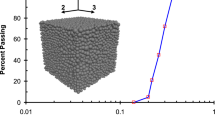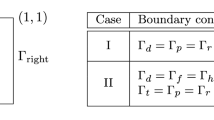Abstract.
A phase-transitional flow takes place during the filling stage by injection molding of short-fiber reinforced thermoplastics. The mechanical properties of the final product are highly dependent on the flow-induced distribution and orientation of particles. Therefore, modelling of the flow which allows to predict the formation of fiber microstructure is of particular importance for analysis and design of load bearing components.
The aim of this paper is a discussion of existing models which characterize the behavior of fiber suspensions as well as the derivation of a model which treats the filling process as a phase-transitional flow of a binary medium consisting of fluid particles (liquid constituent) and immersed particles-fibers (solid-liquid constituent). The particle density and the mass density are considered as independent functions in order to account for the phenomenon of sticking of fluid particles to fibers. The liquid constituent is treated as a non-polar viscous fluid, but with a non-symmetric stress tensor. The state of the solid-liquid constituent is described by the antisymmetric stress tensor and the antisymmetric moment stress tensor. The forces of viscous friction between the constituents are taken into account. The equations of motion are formulated for open physical systems in order to consider the phenomenon of sticking. The chemical potential is introduced based on the reduced energy balance equation. The second law of thermodynamics is formulated by means of two inequalities under the assumption that the constituents may have different temperatures. In order to take into account the phase transitions of the liquid-solid type which take place during the flow process a model of compressible fluid and a constitutive equation for the pressure are proposed. Finally, the set of governing equations which should be solved numerically in order to simulate the filling process are summarized. The special cases of these equations are discussed by introduction of restricting assumptions.
Similar content being viewed by others
References
Advani, S. G., Tucker, C. L.: The use of tensors to describe and predict fiber orientation in short fibers composites. J. Rheol. 31, 751-784 (1987)
Advani, S. G., Tucker, C. L.: Closure approximations for three-dimensional structure tensors. J. Rheol. 34, 367-386 (1990)
Altan, M. C., Rao, B. N.: Closed-form solution for the orientation field in a center-gated disk. J. Rheol. 39, 581-599 (1995)
Altan, M. C., Subbiah, S., Güçeri, S. I., Pipes, R. B.: Numerical prediction of three-dimensional fiber orientation in Hele-Shaw Flows. Polym. Eng. Sci. 30, 848-859 (1990)
Altenbach, J., Altenbach, H.: Einführung in die Kontinuumsmechanik. Teubner Studienbücher Mechanik. Stuttgart: Teubner (1994)
Batchelor, G. K.: The stress system in a suspension of force free particles. J. Fluid Mech. 41, 545-570 (1970)
Bay, R. S., Tucker, C. L.: Fiber orientation in simple injection moldings. Part 1: theory and numerical methods. Polym. Comp. 13, 317-331 (1992)
Bay, R. S., Tucker, C. L.: Fiber orientation in simple injection moldings. Part 2: experimental results. Polym. Comp. 13, 332-341 (1992)
Brenner, H., Condiff, D. W.: Transport mechanics of orientable particles III. Arbitrary particles. Rheol. Acta 41, 228-274 (1971)
Chung, S. T., Kwon, T. H.: Numerical simulation of fiber orientation in injection molding of short-fiber reinforced thermoplastics. Polym. Eng. Sci. 35, 604-618 (1995)
Cintra, J. S., Tucker, C. L.: Orthotropic closure approximations for flow-induced fiber orientation. J. Rheol. 39, 1095-1122 (1995)
Dinh, S. M., Armstrong, R. C.: A rheological equation of state for semiconcentrated fiber suspensions. J. Rheol. 28, 207-227 (1984)
Doi, M., Edwards, S. F.: The Theory of Polymer Dynamics. Oxford: Oxford University Press (1988)
Dupret, F., Couniot, A., Mal, O., Vanderschuren, L., Verhoyen, O.: Modelling and simulation of injection molding. In: Siginer, D. A., Kee, D. D., Chhabra, R. P. (Eds.): Advances in the Flow and Rheology of Non-Newtonian Fluids. Amsterdam: Elsevier, pp. 939-1010 (1999)
Dupret, F., Verleye, V.: Modelling of the flow of fiber suspensions in narrow gaps. In: Siginer, D. A., Kee, D. D., Chhabra, R. P. (Eds.): Advances in the Flow and Rheology of Non-Newtonian Fluids. Amsterdam: Elsevier, pp. 1347-1398 (1999)
Ericksen, J. L.: Anisotropic fluids. Arch. Rational Mech. Anal. 3, 231-237 (1960)
Ericksen, J. L.: Transversely isotropic fluids. Kolloid-Zeitschrift 173, 117-122 (1960)
Eringen, A. C.: Continuum theory of dense rigid suspensions. Rheologica Acta 30, 23-32 (1991)
Eringen, A. C.: Microcontinuum Field Theories. II:Fluent Media. New York: Springer (2001)
Faria, S. H.: Mixtures with continuous diversity: general theory and application to polymer solutions. Continuum Mech. Thermodyn. 13, 91-120 (2001)
Giesekus, H.: Phänomelogische Rheologie. Berlin: Springer (1994)
Glaser, S., v Diest, K.: Berechnungsverfahren für GFK-Bauteile. Kunststoffe 88, 537-542 (1988)
Halmos, P. R.: Measure Theory. New York: Springer (1974)
Hegler, R. P.: Faserorientierung beim Verarbeiten kurzfaserverstärkter Thermoplaste. Kunststoffe 74, 271-277 (1984)
Huilgol, R. R., Phan-Thien, N.: Fluid Mechanics of Viscoelasticity. Amsterdam: Elsevier (1997)
Jeffery, G. B.: The motion of ellipsoidal particles immersed in a viscous fluid. Proc. R. Soc. London A 102, 161-179 (1922)
Kennedy, P.: Flow Analysis of Injection Molds. Munich: Hanser Publishers (1995)
Lurie, A. I.: Nonlinear Theory of Elasticity. Amsterdam: North-Holland (1990)
Menning, G.: Werkzeuge für die Kunststoffverarbeitung. München: Carl Hanser Verlag (1995)
Michaeli, W.: Plastics Processing. Munich: Hanser Publishers (1995)
Munganga, J. M. W., Reddy, B. D., Diatezua, K. J.: Aspects of the thermodynamic stability of fibre suspension flows. J. of Non-Newtonian Fluid. Mech. 92, 135-150 (2000)
Palmov, V. A.: Vibrations of Elasto-Plastic Bodies. Berlin: Springer (1998)
Petrie, C. J. S.: The rheology of fibre suspensions. J. Non-Newtonian Fluid Mech. 87, 369-402 (1999)
Probstein, R. F.: Physicochemical Hydrodynamics. New York: John Wiley and Sons (1994)
Ranganathan, S., Advani, S. G.: A Simultaneous solution for flow and fiber orientation in axisymmetric diverging radial flow. J. of Non-Newtonian Fluid. Mech. 47, 107-136 (1993)
Saito, M., Kukula, S., Kataoka, Y., Miyata, T.: Practical use of statistically modified laminate model for injection moldings. Material Science and Engineering A 285, 280-287 (2000)
Schmachtenberg, E., Yazici, N. M., Schröder, O.: Untersuchung des Langzeitfestigkeitsverhaltens von Pumpenbauteilen aus Kunststoff. Abschlußbericht, AIF Forschungsvorhaben, Auftraggeber: WILO GmbH Dortmund, Universität Essen, Institut für Kunststofftechnik und Kunststoffmaschinen (2000)
Truesdell, C. A.: Rational Termodynamics. New York: Springer (1984)
Tucker, C. L., Advani, G.: Processing of short-fiber systems. In: Advani, S. G. (Ed.): Flow and Rheology in Polymer Composites Manufacturing. Amsterdam: Elsevier, pp. 147-202 (1994)
Vincent, M., Agassant, J. F.: Experimental study and calculations of short glass fiber orientation in a center gated molded disc. Polym. Comp. 7, 76-83 (1986)
Whiteside, B. R., Coates, P. D., Hine, P. J., Duckett, R. A.: Glass fibre orientation within injection moulded automotive pedal. Simulation and experimental studies. Plastics, Rubber and Composites 29, 38-45 (2000)
Zhilin, P. A.: Mechanics of Deformable Directed Surfaces. Int. J. Solids Structures 12, 635-648 (1976)
Zhilin, P. A.: A New Approach to the Analysis of Free Rotations of Rigid Bodies. ZAMM 76, 187-204 (1996)
Zhilin, P. A.: The basic equtions of the inelastic media. In: Indeitsev, D. A. (Ed.): Actual Problems in Mechanics. St. Petersburg: Institute for Problems in Mechanical Engineering of Russian Academy of Sciences, pp. 14-58 (2000) (in Russian)
Zhilin, P. A.: Vectors and second rank tensors in 3D-space. St. Petersburg: Nestor (2001) (in Russian)
Author information
Authors and Affiliations
Corresponding author
Additional information
Communicated by H. Ehrentraut
Received: 6 May 2002, Accepted: 16 December 2002, Published online: 29 July 2003
PACS:
83.10.Ff, 83.70.Hg, 83.50.Cz
Correspondence to: H. Altenbach
Rights and permissions
About this article
Cite this article
Altenbach, H., Naumenko, K. & Zhilin, P.A. A micro-polar theory for binary media with application to phase-transitional flow of fiber suspensions. Continuum Mech. Thermodyn. 15, 539–570 (2003). https://doi.org/10.1007/s00161-003-0133-5
Issue Date:
DOI: https://doi.org/10.1007/s00161-003-0133-5




